Are you a cat parent who likes to indulge your furry friend with a dollop of whipped cream every now and then? If so, have you ever wondered how much is too much for your kitty? As responsible pet owners, it’s our duty to ensure that the food we give our cats is safe and healthy for their bodies.
So, let’s tackle the question at hand: how often can cats have whipped cream? The answer might surprise you.
Although whipped cream is not toxic to cats, it’s not exactly a nutritious treat either. Cats are lactose intolerant, which means that the cream in whipped cream can cause digestive issues and upset stomachs. Furthermore, this creamy goodness is high in sugar and fat content, which can lead to obesity, diabetes, and other health concerns if consumed excessively.
But don’t fret. Sharing a small amount of whipped cream with your kitty occasionally won’t harm them. In fact, it could even be an enjoyable bonding experience for both of you. Just remember to keep it minimal and opt for healthier treats like tuna or cooked chicken as part of their regular diet.
In this blog post, we’ll delve deeper into the topic of how often cats can have whipped cream while also exploring some alternative options that will keep your feline friend happy and healthy. So let’s dive in.
Cats Are Obligate Carnivores
This means that their bodies require a diet that is primarily composed of animal protein in order to properly function and thrive. In the wild, cats hunt and consume small prey, such as mice, birds, and insects, which provide them with the essential nutrients they need.
However, domestic cats have evolved to rely on humans for their nutritional needs. It’s crucial to provide them with a balanced diet that meets their specific dietary requirements. This typically involves feeding them a high-quality commercial cat food that is rich in animal protein as the primary ingredient. A diet solely based on plant-based proteins cannot provide all the necessary nutrients for feline health.

Despite the importance of a well-rounded diet, some pet owners may be tempted to offer their cats whipped cream as a treat. However, whipped cream has no nutritional value and may even pose harm to the health of cats.
Whipped cream is a dairy product that contains sugar and other additives that are not beneficial to feline health. While it may be enjoyable for some cats as an occasional treat, it should not be included in their regular diet. Here are some reasons why:
- High Fat Content: Cats require a balanced diet that includes healthy fats in moderation. However, whipped cream is high in fat and can lead to weight gain and other health issues if consumed regularly.
- Sugar Content: Just like humans, cats can suffer from negative health effects from consuming too much sugar. This includes dental issues and weight gain.
- Lactose Intolerance: Cats are not designed to digest dairy products like humans are. Some cats may be lactose intolerant, which means they cannot properly digest dairy products such as whipped cream. Feeding your lactose intolerant cat whipped cream can cause digestive issues and discomfort.
The Nutritional Value of Whipped Cream for Cats
When it comes to the nutritional value of whipped cream for cats, it’s important to exercise caution.
Let’s start with the not-so-great news: whipped cream is high in fat and calories. Just one tablespoon of this sweet treat contains around 50 calories and 5 grams of fat. For the average-sized cat, this is a significant amount and could lead to health problems if consumed regularly. As obligate carnivores, cats require a diet high in animal protein, making it vital to prioritize their nutritional needs over their desire for a sweet snack.
Moreover, whipped cream contains dairy, which can cause digestive issues for cats who are lactose intolerant. Many cats struggle to digest lactose, leading to gastrointestinal problems such as diarrhea and vomiting. It’s best to avoid giving your cat anything that may upset their stomachs.
While there are some potential benefits to feeding your cat whipped cream in moderation – such as the small amount of calcium and protein it contains – there are many other cat-friendly foods that can provide these nutrients without the added risk of excess fat and lactose.
Here are some examples of healthy snacks for your feline friend:
- Cooked chicken or turkey
- Fish (in moderation)
- Small amounts of plain yogurt (if your cat is not lactose intolerant)
- Cooked eggs
- Fresh fruits and vegetables (such as blueberries or green beans)

Moderation is Key When Feeding Your Cat Whipped Cream
Cats have a sweet tooth just like us humans, and it’s not uncommon for them to enjoy indulging in treats like whipped cream. However, it’s important to remember that moderation is key when feeding your cat whipped cream.
Firstly, cats are carnivorous animals and don’t require any dairy products in their diet. It’s worth noting that some cats may even be lactose intolerant, which means they cannot digest lactose properly and may experience digestive issues such as diarrhea, vomiting or flatulence. As such, it’s vital to prioritize your cat’s nutritional needs over their desire for a sweet snack.
Whipped cream is loaded with high levels of fat, sugar, and calories that can lead to obesity and other health problems if given in excessive amounts. To ensure your cat stays healthy and happy, it is recommended that treats should only make up 10% of their daily calorie intake. This means that when feeding your cat whipped cream, it should only be given as an occasional treat and in small quantities.
It’s also crucial to check the label before giving your cat any whipped cream product. Some whipped cream products may contain additives or preservatives that can be harmful to cats. Make sure to avoid any containing xylitol, which is a sugar substitute that can be toxic to cats.
To summarize, while feeding your cat whipped cream can be an enjoyable treat for them, it’s essential to practice moderation. Here are some key takeaways:
- Check the label for harmful ingredients
- Keep serving sizes small
- Remember that treats should only make up 10% of your cat’s daily calorie intake

Potential Health Risks of Feeding Your Cat Whipped Cream
When it comes to feeding your cat whipped cream, it’s important to take a step back and analyze the potential consequences. While the sweet, airy treat may seem harmless, there are actually several potential health risks associated with feeding your cat whipped cream.
One major concern is the high fat content in whipped cream. Just like in humans, obesity can lead to a host of health problems in cats, including diabetes, heart disease, and joint issues. It’s essential to prioritize your cat’s nutritional needs over their cravings for a sweet snack.
Not only that, but most whipped creams contain dairy products that many cats are lactose intolerant to. This can cause gastrointestinal upset, such as diarrhea or vomiting. In more severe cases, it can even lead to painful inflammation of the pancreas.
Moreover, whipped cream often contains sugar and artificial sweeteners that can be detrimental to cat health. Sugar can cause tooth decay and obesity over time, while artificial sweeteners like xylitol can be toxic and cause severe reactions.
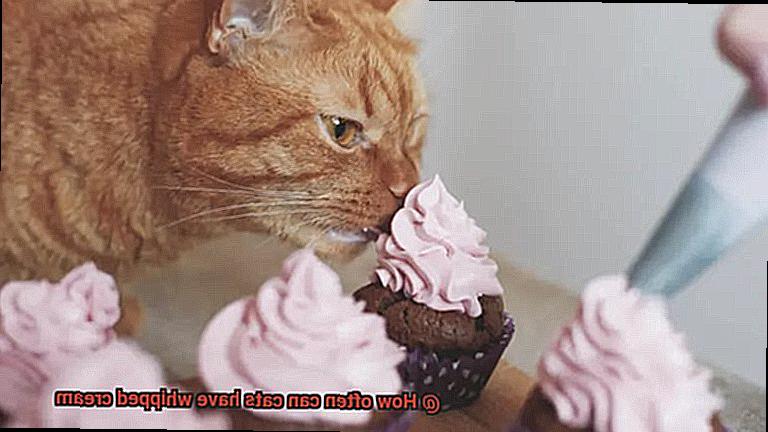
To ensure your cat’s wellbeing, it’s crucial to avoid feeding them whipped cream altogether. Even small amounts can pose a risk to their health. Instead, opt for cat-friendly treats or stick to their regular diet.
Here are some practical tips for keeping your furry friend healthy and happy:
- Offer them healthy cat-friendly treats such as boiled chicken or tuna
- Stick to their regular diet as much as possible
- Keep them physically active with toys and playtime
- Monitor their weight regularly
- Consult with a veterinarian about any dietary concerns you may have
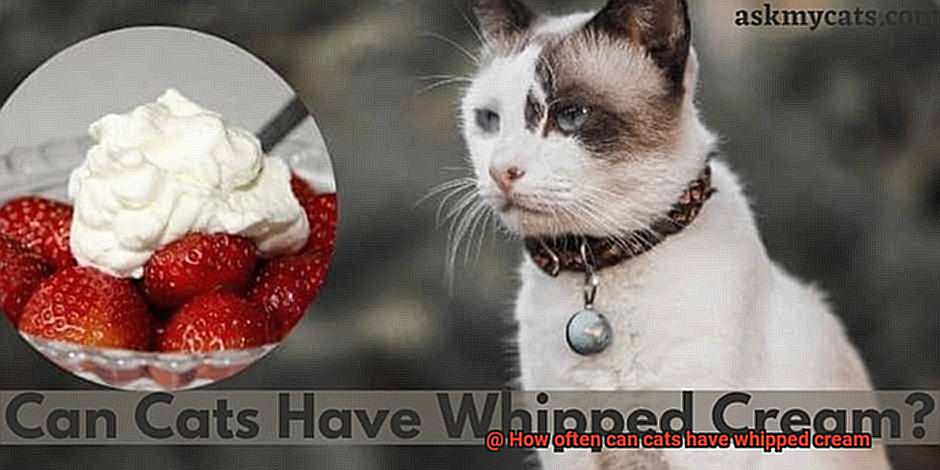

Considerations for Lactose Intolerant Cats
Before you let your cat lick the whipped cream off your spoon, it’s important to consider if they are lactose intolerant.
Lactose intolerance is a common condition in cats where their bodies are unable to properly digest lactose, a sugar found in dairy products like whipped cream. If your cat is lactose intolerant, feeding them whipped cream can lead to unpleasant gastrointestinal symptoms like diarrhea, vomiting, and abdominal pain.
To avoid any potential discomfort for your feline friend, it’s best to steer clear of whipped cream altogether and opt for lactose-free or dairy-free alternatives such as coconut whipped cream or non-dairy yogurt. Be sure to read labels carefully to avoid any hidden ingredients that could be harmful to your cat.
Even if your cat isn’t lactose intolerant, it’s still important to limit their intake of whipped cream due to its high fat and sugar content. Overindulging in this treat can lead to health issues like weight gain, diabetes, and heart disease. Treats should always be given in moderation and never replace a balanced diet.
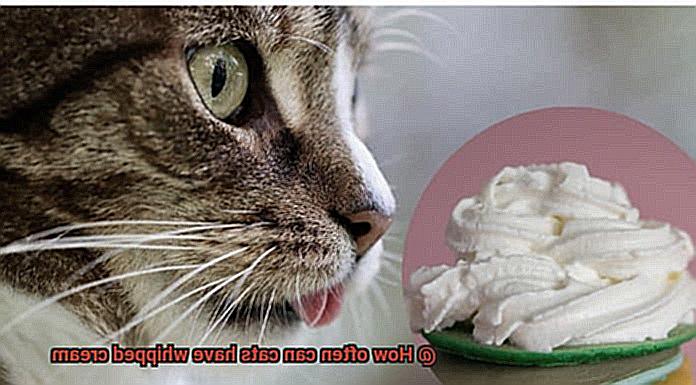
In summary, here are some considerations for feeding whipped cream to cats:
- Determine if your cat is lactose intolerant.
- Opt for lactose-free or dairy-free alternatives.
- Read labels carefully.
- Limit intake of whipped cream.
- Give treats in moderation and never replace a balanced diet.
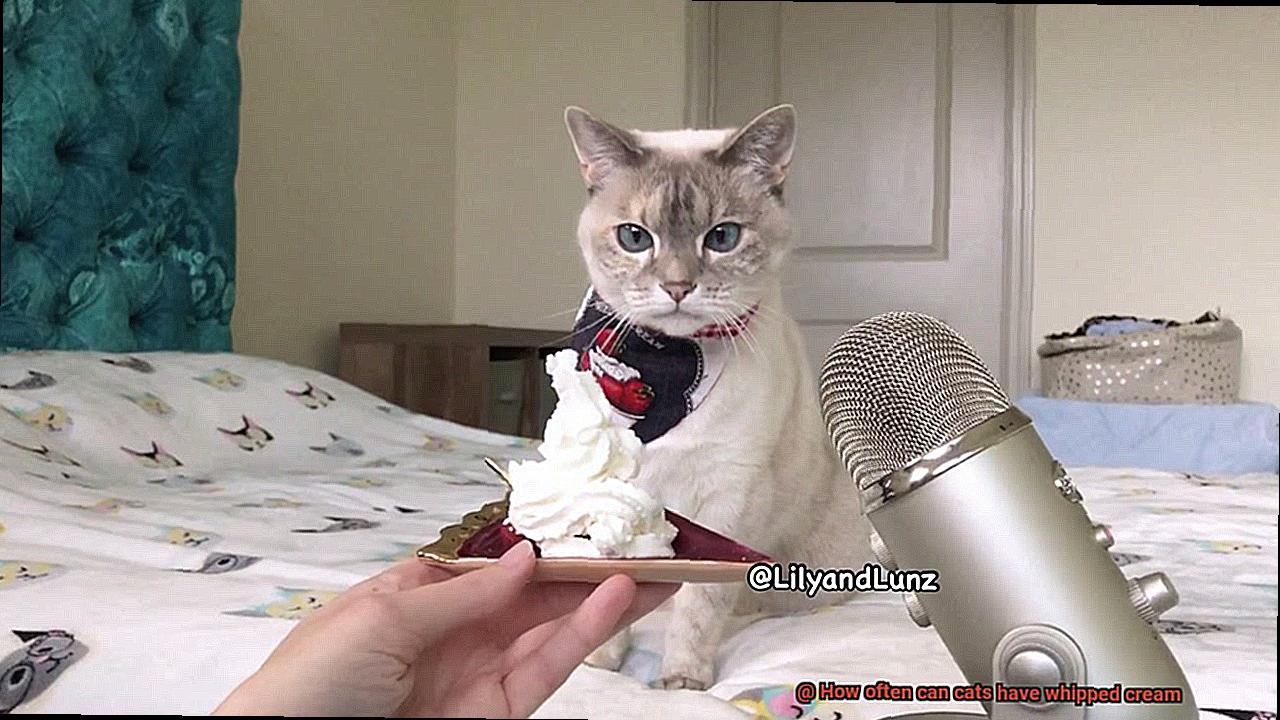
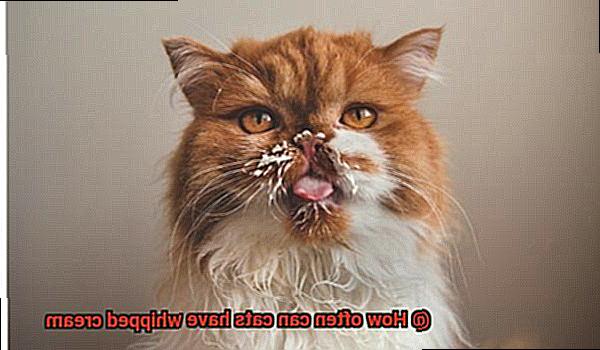
Alternatives to Whipped Cream for Treats
As much as we adore our feline friends and want to shower them with treats, it’s important to note that not all human foods are safe for cats. Whipped cream may seem like a harmless indulgence, but it’s actually not recommended for cats due to its high fat and sugar content. But don’t worry, we’ve got you covered with some delightful alternatives to whipped cream that your cat will love.
First on the list is plain, unsweetened yogurt. Not only is it lower in fat and sugar than whipped cream, but it’s also packed with beneficial probiotics that can aid in your cat’s digestion. This tangy treat will have your kitty purring with delight.
Another scrumptious option is pureed pumpkin. This low-calorie treat is high in fiber, making it an excellent choice to help regulate your cat’s digestive system. You can serve it plain or mix it with a small amount of unsweetened yogurt for added flavor – either way, your cat is sure to lap it up.
If you’re feeling generous and want to spoil your furry friend, consider offering them a small piece of cooked chicken or fish. Be sure to remove any bones and avoid seasoning the meat with salt or other spices – plain and simple is always best when it comes to your cat’s diet.
Of course, there are plenty of commercial cat treats available on the market that are specifically formulated for feline nutrition. When choosing a treat for your cat, read the ingredients list carefully and avoid products that contain fillers or artificial preservatives.
Remember, while treats can be a great way to bond with your cat and show them some extra love, they should never replace a balanced diet. Only offer treats in moderation, limiting them to no more than 10% of your cat’s daily calorie intake. If you have any concerns about your cat’s diet, consult with your veterinarian.
Tips on How to Safely Introduce New Foods to Your Cat
However, introducing new foods to your cat requires careful consideration and caution. Cats have sensitive digestive systems, and sudden changes in their diet can lead to upset stomachs and other health issues. The following tips will help you safely introduce new foods to your cat.
Start with Small Amounts
When introducing new foods to your cat, it’s important to start with small amounts. This allows your cat’s digestive system to adjust slowly to the new food, reducing the likelihood of digestive upset. You can gradually increase the amount over time if your cat seems to enjoy the new food and doesn’t experience any negative side effects. Remember, cats are creatures of habit, so be patient as they adjust to new tastes.
Introduce One Food at a Time
It’s also a good idea to introduce one new food at a time. This way, you can monitor your cat’s reaction and determine if there are any adverse effects. If you introduce multiple new foods at once, it can be difficult to determine which food is causing any issues. Slowly and carefully introduce new foods over several days or weeks for best results.
Choose High-Quality Ingredients
When selecting new foods for your cat, look for high-quality, natural ingredients that are free from fillers and artificial preservatives. You may also want to consult with your veterinarian or a veterinary nutritionist to ensure that the new food is nutritionally balanced and appropriate for your cat’s individual needs. Always read the labels of the foods you’re giving your cat.
Monitor Your Cat’s Reaction
Pay attention to your cat’s body language and behavior during the introduction process. If your cat shows signs of reluctance or disinterest in the new food, it may be best to wait before trying again. Similarly, if your cat experiences any adverse reactions such as vomiting or diarrhea, stop feeding the new food immediately and consult with your veterinarian. Your cat’s health is your top priority.
Be Cautious with Human Foods
Not all human foods are safe for cats to eat. Some common foods that are toxic to cats include chocolate, onions, garlic, and grapes. Before introducing any new human food to your cat, do some research and make sure it’s safe for them to consume. And when it comes to treats like whipped cream, remember that moderation is key. While a small amount of whipped cream may be safe for cats on occasion, it should not be a regular part of their diet.
c2Sf0TY_njI” >
Conclusion
In conclusion, it’s crucial to be mindful of the potential risks associated with feeding your cat whipped cream. Though it may seem like a harmless treat, this sweet indulgence is high in fat and sugar content, which can lead to health concerns such as obesity and diabetes if consumed excessively. Furthermore, most cats are lactose intolerant, making dairy products like whipped cream difficult for them to digest.
But don’t fret. You can still spoil your feline friend with a special treat from time to time. There are plenty of healthy alternatives that can provide your cat with the nutrients they need without the added risk of excess fat and lactose. Think cooked chicken or turkey, fish (in moderation), small amounts of plain yogurt (if your cat is not lactose intolerant), cooked eggs, and fresh fruits and vegetables.
When introducing new foods to your cat, start slowly and introduce one food at a time. Opt for high-quality ingredients that are free from fillers and artificial preservatives. Keep a close eye on your cat’s reaction during the introduction process and seek advice from your veterinarian if you have any concerns.
Remember, treats should only make up 10% of your cat’s daily calorie intake. While it may be tempting to indulge your furry friend with a dollop of whipped cream every now and then, moderation is key when it comes to their health and wellbeing.







